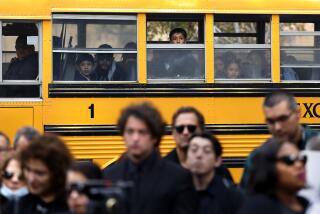Autism genomes add to disorder’s mystery
Less than a third of siblings with autism shared the same DNA mutations in genes associated with the disorder, according to a new study that is the largest whole-genome sequencing for autism to date.
Canadian researchers sequenced whole genomes from 170 siblings with autism spectrum disorder and both their parents. They found that these sibling pairs shared the same autism-relevant gene variations only about 31% of the time, according to the study published online Monday in the journal Nature Medicine.
More than a third of the mutations believed to be relevant to autism arose in a seemingly random way, the study also found.
“It isn’t really autism; it’s autisms,” said the study’s lead investigator, Dr. Stephen W. Scherer, head of the Center for Applied Genomics, Genetics and Genome Biology at the Hospital for Sick Children in Toronto. In some cases, he added, “it’s like lightning striking twice in the same family.”
The results are part of 1,000 whole genomes that are being made available to researchers via a massive Google database that autism advocates hope will grow to 10 times that size by next year.
The effort, spearheaded by the research and advocacy group Autism Speaks, has been somewhat controversial from the start, with some questioning whether results from the relatively costly and time-consuming process will be too complicated or obscure to yield significant breakthroughs.
Indeed, researchers associated with the effort acknowledged that much of their data remain a mysterious ocean of jumbled, deleted or inserted DNA code, much of which is not located on areas of the genome that program the proteins that directly affect biological functions.
“You might expect that you’d see some commonalities in the mutations between kids in the same family, but that’s actually not the case here,” said Rob Ring, chief science officer of Autism Speaks. “We’re not really sure what might explain that at this time.”
Said Scherer: “We’ve really just scratched the surface of this data.”
That’s where Google’s cloud-based data capabilities will come in, according to Ring and Scherer. Making these whole genomes – potentially 10,000 of them – available to any researcher could yield unexpected connections and order in data that are the equivalent of more than 13 years of streaming high-definition television programming.
Even the more limited data from several hundred genomes sequenced in the study proved difficult to handle. “We couldn’t transfer it over the Internet,” said Scherer. “We had to buy hard drives and Fed-Ex them.”
Autism Speaks hopes the database will attract researchers from varied fields, including those outside of genetics.
“It may be a genetic code as it rolls off of sequencers, but it’s just data and numbers,” Ring said.
Other sequencing studies have examined more children diagnosed with autism, but involved single siblings with the diagnosis and have focused on a narrower part of the genome – a little more than 1% of the genome that codes the proteins that carry out biological processes.
The Canadian study is the largest of so-called “multiplex” families with more than one child diagnosed with the disorder.
The researchers had examined a smaller batch of 32 family genomes in 2013, uncovering damaging variations of four genes not previously correlated to autism spectrum disorder. That study also identified mutations in 17 other known or suspected autism genes. The small variations in DNA coding it found accounted for about 19% of the autism cases, the study found.
The current study found autism-relevant mutations in 36 of the 85 families studied. Those mutations were shared by siblings in only 11 of those 36 families, and 10 of those were inherited.
Advocates for whole-genome sequencing argue that their approach picks up all kinds and sizes of mutations, including much smaller additions and deletions of code, than are detected in other forms of sequencing. The study noted that more than 95% of one particular category of coding variation would have been missed by narrower approaches.
The cost and time involved in whole genome sequencing are rapidly declining, while cloud-based computing opens up massive computational power that could potentially make sense of the vast database, advocates say.
Critics have argued that turning up more small oddities may not necessarily be helpful, given that many are so rare that it will be hard to make any statistical sense of them. Even some of the strongest “autism gene” candidates are associated with only a small fraction of autism cases, they note.
Still, genomics is increasingly examining the potential roles of vast stretches of DNA that do not directly code proteins, or that lie outside of genes. Those areas can affect how genes are expressed and how they interact with the environment.
Autism Speaks has committed $50 million to the whole-genome sequencing effort so far, Ring said. The portal to the 1,000 genomes should be in place by the second quarter this year, he said.
Other sources of funding included Genome Canada and the Canadian Institute for Advanced Research.
Science in your DNA? Follow me on Twitter: @LATsciguy







